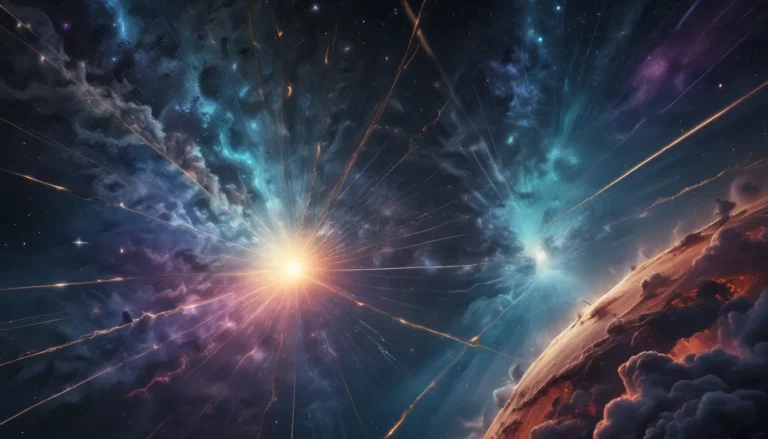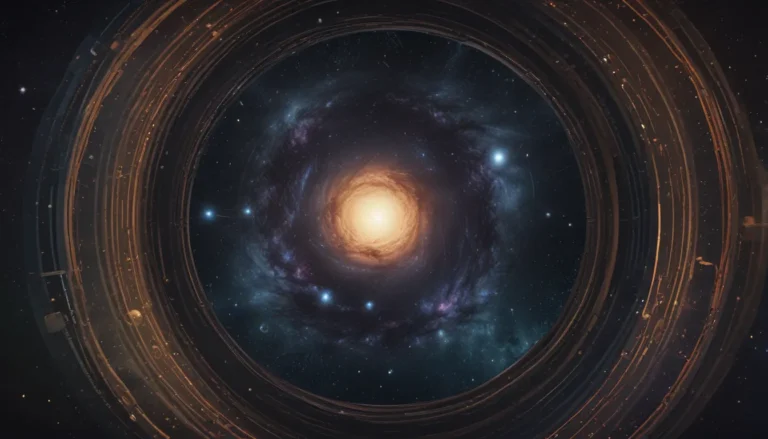The pictures we use in our articles might not show exactly what the words say. We choose these pictures to make you interested in reading more. The pictures work together with the words but don’t take their place. The words still tell you the important facts.
Galactic outflows, the cosmic phenomena that propel gas and dust at incredible speeds from the centers of galaxies, hold the key to understanding the evolution of our universe. In this article, we will embark on a journey through the mesmerizing world of galactic outflows and uncover 20 surprising facts that shed light on these enigmatic cosmic spectacles. From their origins and mechanisms to their impact on star formation and the intergalactic medium, we will unravel the mysteries of these powerful forces that shape the cosmic landscape.
Understanding Galactic Outflows
Galactic outflows are powerful streams of gas and particles that are expelled from galaxies, carrying with them a significant amount of energy and matter. These outflows play a crucial role in the evolution of galaxies by regulating star formation and distributing heavy elements throughout the universe.
Driven by Supermassive Black Holes
At the heart of most galaxies lies a supermassive black hole, whose intense gravitational forces can launch outflows at speeds of thousands of kilometers per second. These outflows can extend thousands of light-years beyond the boundaries of galaxies, showcasing their immense power and impact.
Transporting Vast Amounts of Energy
Galactic outflows transport staggering amounts of energy, equivalent to millions or even billions of supernovae. This makes them one of the most energetic phenomena in the universe and highlights their ability to influence the dynamics of galaxies.
Regulating Star Formation
By sweeping away gas and dust from their host galaxies, galactic outflows can suppress the formation of new stars. This self-regulatory mechanism helps maintain the delicate balance between the creation and destruction of stars within galaxies.
Enriching the Intergalactic Medium
As galactic outflows travel through space, they release heavy elements like carbon, oxygen, and iron into the intergalactic medium. This enrichment contributes to the formation of new stars and galaxies, shaping the cosmic landscape on a grand scale.
Triggering the Formation of New Stars
Although galactic outflows can suppress star formation within their host galaxies, they can also trigger the birth of new stars in neighboring galaxies. The expelled gas and energy fuel the formation of dense regions where stars can emerge.
Influencing the Growth of Black Holes
The outflows generated by supermassive black holes can impact the growth of these cosmic giants. By removing gas and dust from their vicinity, these outflows can either starve or fuel the accretion process, leading to changes in the black hole's size and mass.
Shaping the Morphology of Galaxies
Galactic outflows can have a profound impact on the shape and structure of galaxies. Their interactions with surrounding gas can distort the morphology of galaxies, resulting in the formation of unique features like galactic winds and loops.
Producing Cosmic Rays
High-speed particles entrained in galactic outflows can generate cosmic rays, which permeate the universe as highly energetic particles. These cosmic rays play a vital role in the interstellar medium and contribute to the overall structure of galaxies.
Observed in Different Wavelengths
Astronomers study galactic outflows using a variety of instruments that observe different wavelengths of light. From X-rays to radio waves, these observations provide valuable insights into the nature and behavior of galactic outflows.
Impact on Planetary Systems
Galactic outflows sweeping through galaxies can disrupt the formation of planetary systems by impacting the stability and composition of protoplanetary disks. This interference can alter the conditions necessary for planet formation within galaxies.
From Nearby to Distant Galaxies
Advances in observational technology have allowed researchers to detect galactic outflows in galaxies both nearby and billions of light-years away. This suggests that these outflows have played a significant role in galactic evolution throughout cosmic history.
Feedback Effect on Galaxies
Galactic outflows generated by galaxies can have a feedback effect on their hosts, suppressing further gas accretion, quenching star formation, and regulating the growth of supermassive black holes. This delicate balance influences the evolution of galaxies over time.
Implicated in Galactic Clusters
Galactic outflows are believed to have contributed to the formation of galactic clusters by converging expelled gas and matter from multiple galaxies. This process plays a role in shaping the massive structures observed in the universe.
Linked to Galactic “Downsizing”
The concept of galactic downsizing suggests that more massive galaxies cease their star formation earlier than less massive ones. Galactic outflows have been proposed as one of the mechanisms responsible for this phenomenon, influencing the star-forming activity of galaxies.
Role in Metallicity of Galaxies
Galactic outflows play a significant role in determining the metallicity of galaxies by carrying heavy elements into the intergalactic medium. This has implications for the formation of future generations of stars and the overall chemical evolution of galaxies.
Asymmetric Nature of Galactic Outflows
Not all galactic outflows exhibit symmetrical ejection patterns. Some outflows display complex and asymmetric structures, indicating intricate interactions between the expelled material and the surrounding environment.
Indicator of Galaxy Mergers
Powerful outflows can be triggered when galaxies collide and merge, serving as a signature of past or ongoing interactions. These outflows provide insights into the dynamic nature of galactic mergers and their impact on galactic evolution.
Continuous Field of Research
The study of galactic outflows is a dynamic and evolving field, with ongoing efforts to understand their origins, properties, and impact on galaxy evolution. Scientists are exploring new observational techniques and theoretical models to unravel the mysteries of these captivating cosmic phenomena.
Conclusion
In conclusion, galactic outflows are captivating cosmic phenomena that shape the universe in profound ways. From regulating star formation and black hole growth to influencing the morphology of galaxies, these powerful streams of gas and particles play a crucial role in the evolution of galaxies and the distribution of matter throughout the cosmos.
As our understanding of galactic outflows continues to expand, we gain valuable insights into the dynamic nature of the universe and the intricate interplay between galaxies and the cosmic environment. Explore the enigmatic world of galactic outflows and expand your cosmic knowledge with these fascinating facts.
FAQs
- What are galactic outflows?
-
Galactic outflows are streams of gas and particles expelled from galaxies at high velocities.
-
What drives galactic outflows?
-
Energetic processes within galaxies, such as star formation and black hole activity, drive galactic outflows.
-
How fast do galactic outflows travel?
-
Galactic outflows can reach speeds of millions of miles per hour, propelled by energetic processes in galaxies.
-
What role do galactic outflows play in galaxy formation?
-
Galactic outflows regulate star formation and transport material and energy away from galaxies, influencing the growth and evolution of galaxies.
-
How do galactic outflows impact the intergalactic medium?
-
Galactic outflows interact with the intergalactic medium, depositing energy and heavy elements, influencing the chemical and physical properties of the medium.
-
Can galactic outflows be observed from Earth?
-
Yes, galactic outflows can be observed using astronomical instruments that detect different wavelengths of light.
-
Are galactic outflows unique to specific galaxies?
-
No, galactic outflows have been observed in various types of galaxies, indicating their widespread presence in the universe.
-
Are galactic outflows a common phenomenon?
-
Yes, galactic outflows are a common phenomenon and play a vital role in regulating the evolution of galaxies.
-
Can galactic outflows impact the formation of new galaxies?
-
Yes, galactic outflows can disperse gas and influence the formation of new galaxies, shaping their growth and structure.
-
Are there ongoing research efforts dedicated to studying galactic outflows?
- Yes, several research projects and space missions aim to further investigate and understand the complexities of galactic outflows. Explore the mysteries of galactic outflows and deepen your understanding of the cosmic forces that shape our universe.






